
This video offers some advice on using notecards during the types of speeches often given in public speaking classes.
- Subject:
- Business and Communication
- Communication
- Material Type:
- Lecture
- Author:
- Ryan Guy
- Date Added:
- 06/02/2022

This video offers some advice on using notecards during the types of speeches often given in public speaking classes.

This Communication and Argumentation seminar is an intensive writing workshop that focuses on argumentation and communication. Students learn to write and present their ideas in cogent, persuasive arguments and other analytical frameworks. Reading and writing assignments and other exercises stress the connections between clear thinking, critical reading, and effective writing.
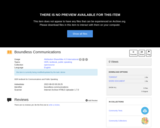
OER textbook for Communications and Public Speaking

The COM100 - Fundamentals of Human Communication is a 16-week full course build.Explore the benefits of effective communication in daily interactions through theoretical and practical approaches to understanding the human communication process. Students will learn communication skills to enhance interpersonal relationships, increase their ability to work in collaborative groups and develop effective presentation skills. File type is a 1.2 Common Cartridge.

In this video you will learn about the differences between in-text citations and oral citations. In addition, we will cover the four criteria of citing sources orally. Please watch the Citing Sources Orally video (2 min. 36 sec.) below. Closed captions in English are available. Recorded with Adobe Spark. Citing Sources Orally
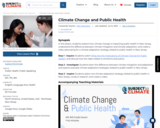
SYNOPSIS: In this lesson, students explore how climate change is impacting public health in New Jersey, understand the difference between climate mitigation and climate adaptation, and create a video advocating for a climate adaptation strategy related to public health in New Jersey.
SCIENTIST NOTES: This lesson challenges students to consider the impacts of climate change on public health. The video defines public health in simple terms and how it affects and will affect students’ lives. Students are then encouraged to discuss how some of the quotes from the video make them feel and to investigate how climate change is linked to public health and justice. The differences between climate mitigation and climate adaptation are outlined, and sources are provided for further investigation. The lesson also includes links to credible sources to help students with their investigation. Students are encouraged to use their creative thinking skills to create a short video about climate adaptation strategies that could benefit New Jersey. This is a good lesson to challenge students' critical thinking and creative skills.
POSITIVES:
-Students collaborate with their peers to create short videos as the assessment in this lesson.
-Students get voice and choice as they select a climate adaptation strategy that matters the most to them.
-If you teach multiple classes, you may be able to share the videos from all of your classes with all of your students.
ADDITIONAL PREREQUISITES:
-Students should have access to the Teacher Slideshow on their own devices in order to explore example climate adaptation strategies, access links, and conduct research.
-There may be student confusion when explaining the difference between climate mitigation and climate adaptation. Students may need more guidance as they choose their climate adaptation strategy. For example, students may gravitate toward "more renewable energy" or "more electric cars." Both of these are examples of climate mitigation strategies. Guide them toward climate adaptation strategies instead.
-Some students may select climate adaptation strategies that are not directly related to public health. This may include building sea walls or planting more drought-resistant crops. These are climate adaptation strategies, but they are not directly related to public health.
-Students can use the examples of how climate change impacts public health in New Jersey on the Teacher Slideshow to brainstorm ideas when choosing a climate adaptation strategy.
DIFFERENTIATION:
-It may be best to group students of mixed ability. Conducting research for their videos might be the trickiest part of the lesson, and students with strong research skills and media literacy may be able to guide their groups.
-Students can take turns being the videographer for their group.
-You may require all students to have speaking roles in their videos. One student may also be the designated videographer for the group.
-You can have students write scripts for their videos before recording. Other groups, however, may simply want to record their videos over and over again until they get a good take.
-Students can record their videos on school-approved devices like laptops, iPads, or iPods. If these devices are not available, it may be necessary to have students use their personal devices.
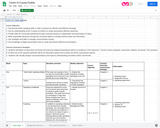
Course outline that adopts the textbook Stand up, Speak out: https://open.lib.umn.edu/publicspeaking/. Spreadsheet tabs include assessments.
Course Description
Introduces speechmaking based primarily on a traditional public speaking approach. Covers classical rhetorical theory and highlights rhetoric's importance to public speaking. Develops theoretical understanding and practical application of oral communication skills. Includes techniques in controlling speech anxiety, how to structure and organize information to present to a variety of audiences, and physical and vocal delivery skills.
Upon successful completion, students should be able to:
Use learned public speaking skills in order to present an effective and efficient message.
Use an understanding of the 5 canons of rhetoric to create and present effective speeches.
Provide skills for community leadership through increased practice in organization and presentation of ideas.
Make responsible decisions through the increased ability to critically examine ideas and information.
Use strategies and skills to manage communication anxiety.
Use knowledge of digital presentation tools to create and present effective presentations.

Let’s consider some common mistakes you should avoid as a presenter.
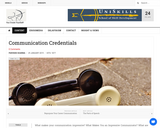
These 7 C’s of Communication have been explained in much detail for those who have been studying Communication. While working with students on the concept of essentials of effective communication, I felt that there is a set of three, which seems to work for me when it comes to delivering a successful and sustained communication. The same has worked in the perfect way for those who have mentored me. It is said that ‘Communication is what it does.’ And it should do exactly what we call 'effective'.
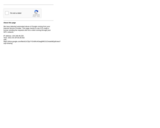
Communications: Public Speaking Syllabus
COMM 111 Public Speaking
This course exposes students to theory and practice in the creation, adaptation and delivery of original speeches before an audience. It also provides the opportunity to understand the nature of public speaking and discourse in both ancient and modern society.
Outcomes
Upon successful completion of this course, students will be able to:
Synthesize, organize information for varied audiences. Interact with confidence while adapting messages to audience needs. Listen critically.
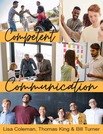
This is both a human communication and public speaking text for the general education course.
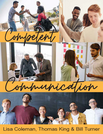
This is both a human communication and public speaking text for the general education course.

This public speaking lesson focuses on presenting and conveying important information, details, facts, and opinions in a concise manner. This lesson presents several different real-world situations where students are asked to share their perspectives, experiences, and stories where they are to give supporting details and facts that are important to the context of different social interactions (talking with peers, colleagues, community, interviews, etc). With the creation of this lesson, different level options of technology integration are offered to allow for flexibility and modifications for this lesson to best serve various classrooms and their students (low tech, medium tech, and high tech options). This lesson will help students analyze a social interaction and/or topic and have them clearly and concisely give an authentic response.
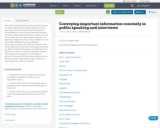
This public speaking lesson focuses on presenting and conveying important information, details, facts, and opinions in a concise manner. This lesson presents several different real-world situations where students are asked to share their perspectives, experiences, and stories where they are to give supporting details and facts that are important to the context of different social interactions (talking with peers, colleagues, community, interviews, etc). With the creation of this lesson, different level options of technology integration are offered to allow for flexibility and modifications for this lesson to best serve various classrooms and their students (low tech, medium tech, and high tech options). This lesson will help students analyze a social interaction and/or topic and have them clearly and concisely give an authentic response.
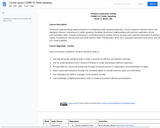
Course uses open textbook Stand Up, Speak Out: The Practice and Ethics of Public Speaking: https://open.lib.umn.edu/publicspeaking/
Course Description
Introduces speechmaking based primarily on a traditional public speaking approach. Covers classical rhetorical theory and highlights rhetoric's importance to public speaking. Develops theoretical understanding and practical application of oral communication skills. Includes techniques in controlling speech anxiety, how to structure and organize information to present to a variety of audiences, and physical and vocal delivery skills.
Course Objectives - CCOGs
Upon successful completion, students should be able to:
Use learned public speaking skills in order to present an effective and efficient message.
Use an understanding of the 5 canons of rhetoric to create and present effective speeches.
Provide skills for community leadership through increased practice in organization and presentation of ideas.
Make responsible decisions through the increased ability to critically examine ideas and information.
Use strategies and skills to manage communication anxiety.
Use knowledge of digital presentation tools to create and present effective presentations.

Course information and map for first-year, in-person, 10-week class on public speaking and communication skills in delivering speeches and presentations. Includes learning objectives, assignments, readings, and other resources.

Course map for class that emphasizes developing communication skills by examining and demonstrating how self-awareness, audience, content, and occasion influence the creation and delivery of speeches and presentations. Includes learning objectives, assignments, formative feedback, learning activities, and readings as well as other resources.

STUDENT LEARNING OBJECTIVE: Students will be able to create and deliver a well-researched, informative speech about soybeans, demonstrating their understanding of the crop's importance in agriculture and its impact on various industries.MEASURABLE ACHIEVEMENT GOAL: Students will present a 5-minute informative speech about soybeans, covering at least four of the following aspects: history, cultivation, nutritional value, industrial uses, economic importance, and environmental impact. The speech will be evaluated using a rubric that assesses content accuracy, organization, delivery, and use of visual aids. Lesson written by Allison Johnson, Falls City, NE
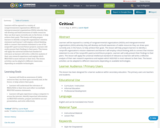
Learners will be exposed to a variety of nongovernmental organizations (NGOs) and intergovernmental organizations (IGOs) whereby they will develop and build awareness of viable resources they can draw upon currently and, in the future, to help achieve their goals. This lesson will help prepare learners to identify a nonprofit organization’s mission statement and learner’s will employ critical thinking skills to connect that mission statement to one of the nonprofit’s past/current/future projects. Learners will orally present their findings to their peers. This lesson will apply the universal intellectual standard of relevance as learners will write a reflective analysis of their own research experience and explain which NGO/IGO is most relevant to their lives. The lesson activities can be adapted to different classrooms depending on available technologies.
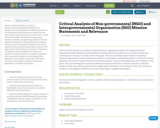
Learners will be exposed to a variety of nongovernmental organizations (NGOs) and intergovernmental organizations (IGOs) whereby they will develop and build awareness of viable resources they can draw upon currently and, in the future, to help achieve their goals. This lesson will help prepare learners to identify a nonprofit organization’s mission statement and learner’s will employ critical thinking skills to connect that mission statement to one of the nonprofit’s past/current/future projects. Learners will orally present their findings to their peers. This lesson will apply the universal intellectual standard of relevance as learners will write a reflective analysis of their own research experience and explain which NGO/IGO is most relevant to their lives. The lesson activities can be adapted to different classrooms depending on available technologies.